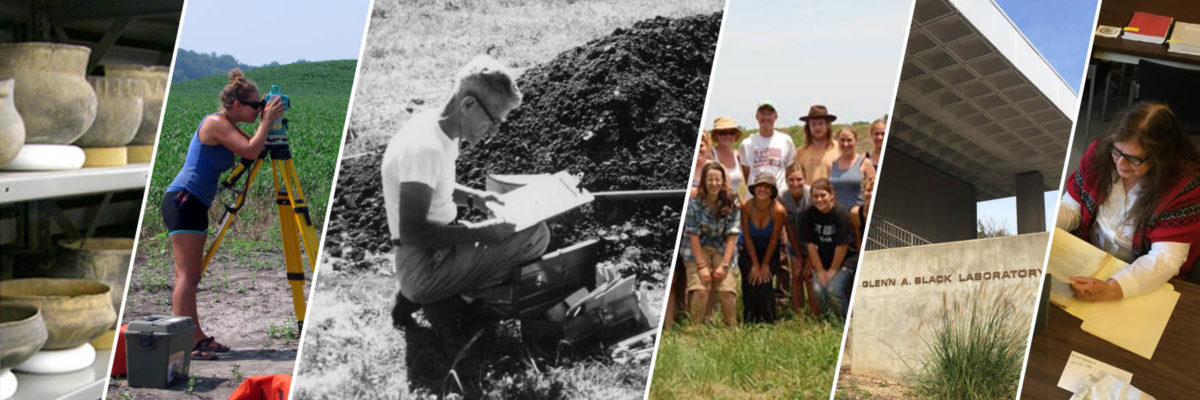By Melody Pope and April Sievert, Principal Investigators and co-Directors of Curating Angel Mounds Legacy Collections
Welcome to the summer blog posting for the Curating Angel Project. The Curating Angel project, funded through the FY2018 Save America’s Treasures grant program monitored by the Institute of Museum and Library Services and National Park Service, is one of the largest Angel Mound collections projects since the transfer of the collection to the Glenn A. Black Laboratory of Archaeology (GBL) in the early 1970s. The bulk of the Angel Mounds collection has been stored in repository Room 16 at the GBL, also known as the Angel Room since the lab opened in 1971.

The collection fills 2,800 cardboard boxes comprising 2,900 ft3. Housed in the original containers used for packing and storing the collections at the Angel Mounds field laboratory, most of the bags inside the boxes have not seen the light of day for 50 to 80 years. Numerous rodent and insect nests and debris in the bags and boxes speak to the effects of pests when collections are stored for over a quarter of a century at makeshift field repositories.

Insect nest and casing debris found in original storage bag (2019) 
Storage repository at Angel Mounds.
(1939; S1513)
In addition to the remains of past pests, many of the bags became feeding grounds for mold. While mold may have resulted initially from poor field storage conditions, inappropriate humidity and temperature controls at the GBL further acerbated the problem. We discovered that many of the boxes housing animal bone were in very bad condition hence we adopted a “worst goes first” approach. This meant starting with the 650 boxes of animal bone. Rehousing the animal bone first not only helps to mitigate the mold problem, but it also expedites the important and timely process of checking and removing human remains that had been inadvertently mixed with the animal bone. IU Environmental Health Services tested the air in the Angel room in the fall of 2019 and reported elevated levels of Penicillium/Aspergillus species, not a surprising outcome based on high seasonal humidity and paper bags of items with mold on them.

Thoroughly cleaning the room to create a safe work environment and hopefully begin to abate mold growth was step one. In addition to vacuuming all surfaces with a HEPA vacuum, we installed an industrial air scrubber. All project staff are required to wear HEPA filtering facepieces and gloves. Industrial dehumidifiers and an air scrubber in the Angel Room help maintain a safe working environment.
The first quarter of the project was officially underway on December 1, 2018. To avoid spreading mold to other areas of the laboratory, we set up the rehousing operation in the Angel Room. A flurry of activity was directed toward configuring and cleaning workspaces, purchasing supplies, evaluating and implementing database needs, developing a box bar coding system, planning workflows, testing work processes, hiring, training, and fitting staff with HEPA filtering masks.

After tripping a few circuits, we also discovered early in the process that new electrical circuits were necessary to run the new air scrubber and dehumidifiers essential to ensuring a safe working environment. The Angel Room now has several new circuits!
By early in the second quarter, rehousing the animal bone boxes was well underway. By June 1, 36 old boxes were transformed into 74 new acid free boxes. The summer rehousing crew consists of an amazing group of students and post-graduates who are getting a lot of hands-on experience in curation and conservation training. While a tedious and thankless job, discarding the old mold and pest infested bags and boxes and seeing the newly rehoused collection is both rewarding and exciting.

Before and After (2019) 
Rehoused Boxes (2019)
The bone preservation from Angel is excellent and it is obvious after our first month of rehousing animal bone that there is a wealth of untapped research potential. Bear, deer, elk, a variety of small mammals, fish, turtle and numerous bird bones await further research on foodways, hunting, discard practices, and the everyday and circumstantial uses to which Mississippian peoples put animals and their byproducts. We project rehousing the estimated 650 boxes of animal bone will be complete by the end of the year.

Rehousing bone also provided an opportunity to learn about types of mold encountered when rehousing legacy collections, the topic of our next Curating Angel blog. In the coming weeks a series of summer blog posts will introduce you to the rehousing team and provide some insights into the collection, its research potential, conservation issues, and the process of curating, storing, and managing the collection in preparation for its transfer to the new IU Auxiliary Library Facility, known as ALF3.

We hope you enjoy following along with us on Curating Angel. It’s almost like excavating Angel Mounds for a second time!
More About IMLS
The Institute of Museum and Library Services is the primary source of federal support for the nation’s libraries and museums. We advance, support, and empower America’s museums, libraries, and related organizations through grantmaking, research, and policy development. Our vision is a nation where museums and libraries work together to transform the lives of individuals and communities. To learn more, visit www.imls.gov and follow us on Facebook and Twitter.

(The views, findings, conclusions, or recommendations expressed in this blog post do not necessarily represent those of the Institute of Museum and Library Services.)

